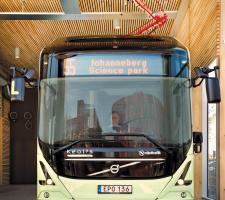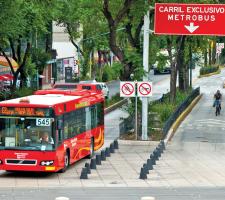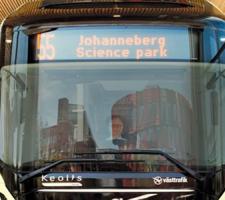
Buses can play a key role in the battle to improve air quality in towns and cities as David Crawford discovers.
A city with a population of half a million would gain about US$12.3 million in annualised societal savings if all its buses ran on electricity instead of diesel. This is the conclusion of a wide-ranging analysis carried out by Swedish bus manufacturer
Reduced levels of air and noise pollution alone would contribute nearly US$3 million in lower healthcare costs - almost a quarter of the total saving according to the analysis, which was first presented at a seminar in New York. The annual reduction in CO2 emissions would total 33,000 tonnes, equivalent to the output of some 3,000 Swedish households.
In their calculation, the two companies have developed a ‘True Total Cost of Ownership’ (TrueTCO) approach. In this, they extend a standard TCO calculation that typically covers the costs of vehicle leasing, fuel, drivers’ wages, garaging and maintenance to include wider socio-economic and environmental costs and benefits.
They have used evaluation techniques, based on KPMG’s True Value methodology, as well as data sourced from ASEK, a working group on cost-benefit analysis in the transport sector that is widely consulted by the Swedish Transport Administration. The Volvo/KPMG TrueTCO for buses includes the negative effects of noise and pollution on public health, the environmental impacts of producing fuel, contributions made to climate change and the time that passengers spend waiting for a service, when they are exposed to pollution.
Comments KPMG Sweden head of sustainability consulting Daniel Dellham: “Electric buses are an excellent example of an innovation that can create substantial societal values. By supplementing standard financial analysis with socio-economic and environmental factors, one arrives at a more complete picture of an investment’s impact on companies and society.”
The publication of the analysis followed on from the June 2015 start of a three-year trial of a new electric bus route in Gothenburg, Sweden’s second city, which has a population of just over 500,000. ElectriCity (a partnership between Volvo, the Swedish Energy Agency, the City of Gothenburg, Chalmers University and public transport operator Västtrafik) is trialling three fully electric and seven electric hybrid vehicles on route 55 which runs between two University campuses through the city centre.
The hybrids are powered by electricity for about 70% of the route with the batteries recharged at route termini.
One of these is located inside one of the buildings of the university (something that would be unacceptable for a conventionally-fuelled bus), where it is testing the scope for silent and emission-free vehicles to operate in areas that would be barred to standard public transport. Researchers linked to the university are now studying the impact on the internal environment, with a view to the implications for other buildings and the planning of Gothenburg’s Frihamnen district, which is being developed to a high urban density.
A Volvo spokesperson told ITS International: “Emission-free vehicles can come closer to where people are and go indoors, a capability which opens up new opportunities in urban planning with, for example, bus stops being located on the ground floors of apartment buildings. The climate in countries such as Sweden means that people appreciate not having to wait outdoors when it rains and is cold.”
| Pollutant | Reduction in concentration (%) |
|---|---|
| CO | 16.6 - 20.4 |
| NOx | 12.9 - 18.1 |
| PM2.5 | 20.8 - 39.0 |
| PM10 | 09.6 - 24.4 |
One question being investigated concerns peoples’ reactions to buses that are moving around indoors (or in other unconventional areas). Another asks how building managers can maintain a satisfactory internal environment when large doors are frequently opening to let buses in and out.
Again, the buses themselves can be sources of heat or cold, depending on the outside temperature. The project is therefore studying ways of using control technology to manipulate the internal climate and so minimise any energy loss.
One solution could involve transmitting data in advance from an incoming bus to the indoor stop, to enable the building to prepare itself for receiving the bus and its passengers.
Advance information on, for example, how many people are likely to be getting off could enable appropriate adjustment of the heating.
At the end of the trial, the batteries from the buses will be reused to store electricity generated by solar power at a new social housing scheme. The hope is that the initiative will spark follow-up moves in other areas of the Västra Götaland region of Sweden, of which Gothenburg is the capital.
A parallel initiative is using route 55 as a live test bed for a new type of bus stop, equipped with Wi-Fi and solar-powered USB charging ports, and also with touchscreens displaying news as well as travel information to help passengers with their route planning.
The stop at Sven Hultins Plats, serving Chalmers University’s Johanneberg Science Park, aims to tackle the less high-profile problem of stress from noise pollution (a level of 75 decibels is calculated as having a health cost of around US$3,700 per person per year). Under trial in the Quiet Public Spaces project is technology designed to muffle the sound of passing traffic to create a more pleasant aural experience.
Meanwhile, a fresh look at the environmental role of bus rapid transit has emerged from researchers Germà Bel and Maximilian Holst of the Research Institute of Applied Economics at the University of Barcelona, Spain. In their ‘Evolution of the Impact of BRT on Air Pollution’ the two claim to have produced a more detailed analysis than has previously been available.
Existing technical literature covering the subject, they say, “does not quantify the reduction in concentrations of the different pollutants. Most assessments are qualitative studies of impact effects or take the form of fuzzy cost-benefit analyses that fail to provide details about individual pollutant levels.”
They take, as the basis for their work, Mexico City’s Metrobus network, which first opened in June 2005. The Mexican capital is one of the world’s most heavily populated metropolitan areas, with over 20 million inhabitants. It is set in a valley which discourages the ready dispersal of air pollutants, levels of which are high in the November to May dry season.
Metrobus came in to relieve pressure on the city’s existing public transport modes which were operating at full capacity, with those who could afford it commuting by car and so contributing to traffic congestion and pollution.
The researchers chose Mexico City for two reasons. First, the importance of the BRT system, which carries over 250 million commuters a year, in the public transit modal mix; and second, the ready accessibility of data generated and recorded over time by the city’s array of modern automatic air quality measuring stations. They analysed this output over periods of two years before and after the opening of the service and focused on five major pollutants: CO, NOX, PM2.5, PM10 and SO2.
Their results show substantial reductions in the concentrations of the first four - depending on the area of the city covered (see table 01) - although those for SO2, an extreme lung irritant, proved inconclusive. The researchers stress that it would be inappropriate to generalise their findings to cover other cities with different geographical and atmospheric traits and the impact on emissions will be different for every corridor.
But they suggest that future studies would benefit from comparing their results with those from other metropolitan areas, looking for evidence of consistency. Such studies could also build on the Institute’s model, by including additional environmental factors such as atmospheric pressure and congestion level variables.
The team concludes that “decision makers that are truly committed to the climate change fight should consider BRT as a public transport option.” For cities with similar characteristics to those of Mexico City, they want to see the creation, encouragement and expansion of BRT networks, to motivate more people to switch from using private cars.
- About the author: David Crawford has spent 20 years writing about and researching ITS and is a Contributing Editor to ITS International.









